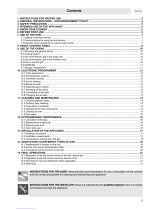
Instructions for the user
7. USE OF THE OVEN
For the models with electronic programmer, before using the oven make sure that the display
shows the symbol .
7.1 Warnings and general advice
Using the oven and the grill for the first time, heat them to the maximum temperature (260°C)
for as long as it takes to burn off any production oil residues which could give a nasty flavour to
the food.
After a power cut, the oven display will flash intermittently and show
. To adjust refer to
paragraph "8. ELECTRONIC PROGRAMMER ”.
During cooking, do not cover the bottom of the oven with aluminium or tin foil and do not place
pans or oven trays on it as this may damage the enamel coating. If you wish to use
greaseproof paper, place it so that it will not interfere with the hot air circulation inside the
oven.
To prevent problems caused by steam in the oven, open the door in two
stages: half open (5 cm approx.) for 4-5 seconds and then fully open. To
access food, always leave the door open as short a time as possible to
prevent the temperature in the oven from falling and ruining the food.
7.2 Use of the electric grill
For short cooking times, for example for browning already-cooked meat, select the static grill
function
; set the thermostat knob to maximum temperature (260°C) and adjust grill intensity
by means of the variable grill knob. The ventilated grill function allows actual cooking to be
done, thanks to the forced ventilation which lets heat penetrate inside the food. For this type of
cooking select the ventilated grill function
, set the thermostat knob to the desired cooking
temperature (never more than 200°C) and adjust grill intensity by means of the variable grill
knob. Cooking time must not exceed 60 minutes.
7.2.1 Operation of the grill + rotisserie
Both the static and the fan grill functions can be used for cooking in
combination with the rotisserie. Fit the spit rod into the rotisserie bushing,
select the
or fan grill function and set the thermostat knob to maximum
temperature (260°C) and adjust grill intensity by means of the variable grill
knob as shown in the figure.
Cooking procedures with grill and rotisserie must never last more than 60
minutes.
All cooking procedures with grill + rotisserie must be carried out with the
door closed to prevent the knobs and front panel of the appliance from
overheating.
1





















